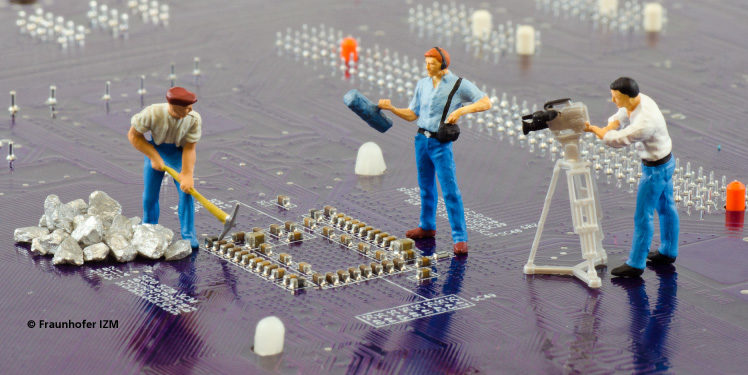Assessing costs and environmental impacts in packaging processes
Mathilde Billaud works on cost and environmental models. Her mission: To optimize panel-level packaging at the process level. A packaging process optimized already at the R&D stage has many benefits to offer, not just by saving costs, but also by having a positive impact on the environment. In our interview, Mathilde talks about the opportunities and challenges of cost modelling.
RealIZM: Tell our readers about yourself and your work.
Mathilde Billaud: I am a research fellow in the environmental and reliability engineering department. I have a background in chemistry and microelectronics. In our department, we are developing and researching environmentally compatible designs for the materialsused in electronics or the IoT. We are helping the microelectronics industry face its current challenges surrounding sustainability, like material scarcity, ways to extend a product’s lifespan etc. Personally, I am working mostly on the panel-level packaging consortium, where are working towards a cost and environmental model for the new technologies.
RealIZM: Please tell us more about your project.
Mathilde Billaud: It is called Fan-out Panel Level Packaging. It is a bit of a mouthful, but it essentially means the development of a particular packaging technology (called fan-out packaging) on an organic (polymer-based) panel, which is rectangular (and not round, as is usually the case). The rectangular substrate used at Fraunhofer IZM is four times larger than the silicon wafer (457 x 610 square millimetres). The idea is that you can produce more packages per substrate. It is all still at the research and development stage, but there are already parts of the microelectronics industry producing packaging on panels at low and high volumes. For our project, we have a consortium with 17 industry partners. On the side of Fraunhofer IZM, it involves three departments: our department works on the cost models and runs reliability tests, while two other departments are elaborating the processes.
RealIZM: What does a cost model mean in this case?
Mathilde Billaud: The point of the cost model is to help perfect the process by modelling the cost of this technology. It is bottom-up modelling, which means that it collects data from all process steps: e.g. the amount of materials, the equipment’s energy consumption, or the processing time. Then we scale it all from the lab level to the fab level to match a given business case (production volume, size of the machine park…) and model a production scenario. The cost model helps us pinpoint which items are the real cost sinks. Process optimization also includes the optimization of the package size and panel design, simply to avoid wasting space on the substrate. We also compare different technologies, so that we understand which option gives you better materials, space etc. With our model, we can show the advantages and drawback of each option in terms of costs.
RealIZM: What about the environmental part?
Mathilde Billaud: We want to make process engineers realize that they have the ability to improve their technology and their approaches towards sustainability. Most of the time, sustainability is not taken into account when it comes to the development of technology. We realized that almost 90% of the carbon footprint comes from the production of the die, rather than the packaging. That means a mistake in the packaging process makes you lose a lot of energy and material, because you lose the die. It is even worse when you produce on a panel scale, rather than on wafers: we lose far more packages and dies when we have to scrap a whole panel, instead of one wafer. That makes a high yield in the packaging process very important. That’s where cost and environmental modelling meet! Investing into processes with higher yield is costly, but pays off environmentally in the long term, even if the invest in the machines and new technologies can sometimes be greater at first.
RealIZM: How are these models connected?
Mathilde Billaud: The data gathered for the cost and environmental models is very closely related. The methods are similar as well. Like I said, mistakes in the packaging process have a high impact on the environment if dies are lost. So, for some process steps, it worth it to invest for higher yield in order to reduce the environmental impact.
RealIZM: That means an environmentally positive model can be negative on the cost side?
Mathilde Billaud: It is not that straightforward. A more reliable process might need longer processing time, more expensive machines, or an additional step, so the cost invest at the beginning might be higher. But if it leads to a higher yield and greater material savings, it might worth it for wholescale production and lead to a cost reduction on a more global scale. It depends on the business scenario. How many products are produced each year? How many packages are produced per panel? Etc. … We really need to study and analyse all this more.
RealIZM: Are you already applying these models?
Mathilde Billaud: There is already one version of the cost model ready from the first Consortium. Right now, we are working on improving it. The environmental model is being developed, as we speak, as part of the Consortium 2.0.
RealIZM: What challenges are you facing?
Mathilde Billaud: The lack of data is definitely our main challenge! We have access to process data at our institute, but we are a research institute, not a real-world fab. Data about fab production is very difficult to find, such as cleanroom facilities, testing phases, handling systems. We cannot take all of these parameters into account. What is most important is that we are clear about the assumptions that we are making in our model.
RealIZM: How do you work exactly?
Mathilde Billaud: The cost model methodology that we have right now is for our technology at Fraunhofer IZM and for our demonstrator. We know each step including all parameters, like the equipment, the required types and amounts of material, the process time, the number of panels that can be processed in this machine etc. On top of those steps, we have a business model in which we define, for example, the number of packages or the design and size of our panels, so that we can scale the process up to the fab level. The business model parameters can be changed quickly and easily. When we merge the business model with our equipment, material, and cleanroom databases, we can scale the Fraunhofer IZM process to a full fab process. You set the production volume, and the model calculates how many machines, people, and panels you need to reach the production targets.
RealIZM: When you develop a cost model, would you recommend optimizations ‘on the fly’ as soon as you notice any?
Mathilde Billaud: Yes. One example is the package/panel design. The packages have more and more dies in them in order to pack more functions. So the packages are getting bigger. When you have bigger packages, it makes sense to produce them on a rectangular substrate, rather than a round substrate, because you lose less space at the edges of the substrate. But that’s not enough. There are ways to optimize the number of rows and columns of packages on the panel to use as much of the available space as possible. So we can already recommend ways to adapt your package size according to your panel size.
RealIZM: Does this only work with processes at our Institute?
Mathilde Billaud: The methodology of the cost model is universal and can be applied to any technology. It is only the databases that need to be adapted. The example that we developed is individually customized to IZM processes, but the goal is to use it also for other technologies and products. The challenge is to get all the information we need about the machines and the equipment.
RealIZM: How should our readers imagine your cooperation with your partners?
Mathilde Billaud: It’s a lot about communicating. We have to be exact about which information we have already, about which information is still missing, and about the assumptions we are making. We need to be very clear, so that our partners are able to reuse the information for their own research. The main challenge here is the lack of data.
Most literature that you can find on cost modelling comes from consulting companies. They usually do not say anything about the methods or where they get their data from. We had to start from scratch, develop the models, and that is why we still need to make assumptions when we try to go from lab-level to fab-level.
RealIZM: Is there a competition in developing cost models?
Mathilde Billaud: In research and development for packaging, there isn’t really. As I said, there are consulting companies that do cost modelling, but their results are not published. And cost modelling tends to get done by ‘reverse engineering’. Since the methodology is not always super clear, it is difficult to compare figures or models. There are too many different parameters that have to be taken into account, which is why you have to make assumptions.
RealIZM: Are there any other challenges you are facing?
Mathilde Billaud: We are currently using Microsoft Excel to develop our model. The amount of data is constantly increasing, and Excel does not seem to be the best tool to handle that. One challenge is definitely finding another tool to develop the models.
RealIZM: What is your vision for cost modelling?
Mathilde Billaud: We want to develop cost and environmental models together. At our Fraunhofer Institute, we are working to support the microelectronic industry, especially in its move towards sustainable production. I want to help the industry get there. One of the key actionable points of the European Green Deal is mobilizing the industry for a cleaner and circular economy. The overall goal of the Green Deal is to get economic growth decoupled from resource consumption by 2050.
It takes 25 years to transform an industrial sector and all the value chains involved. To be ready in 2050, decisions need to be taken within the next five years. If we want to change the microelectronics industry, we need to improve it right NOW.
The microelectronics industry tends to see sustainability as a constraint or even a threat. But it should rather be seen as an opportunity to reinvent products and processes in a smarter and more efficient way.
RealIZM: What problems do you see in terms of connecting microelectronics and sustainability?
Mathilde Billaud: The microelectronics industry tends to ee sustainability as a constraint or even a threat to the industry. But it should rather be seen as a catalyst or an opportunity to reinvent products and processes in a smarter and more efficient way. We are used to tackling technical challenges, and we would never be afraid of them. What we are afraid of are the sustainability challenges, but we should not be. I am sure that we will discover a lot by really engaging with the sustainability question, and I am looking forward to it. On September 1st, we will organize an international conference on this topic: Electronics goes green. In this unusual year, it will have to be an online event, but the presentations will be available for a period of 10 days, so there is no excuse to miss it!
The online registration for the international conference Electronics Goes Green 2020+ is open! More information: https://electronicsgoesgreen.org/registration/
IT CAN BE ALSO INTERESTING FOR YOU:
- Panel Level Packaging Consortium 2.0 – Moving to the Next Level
- Is Heterogeneous Integration a Panacea for the Electronics Industry?
- Three Disruptive Technologies in Microelectronics


